How to Find a Product to Sell on Amazon 2024
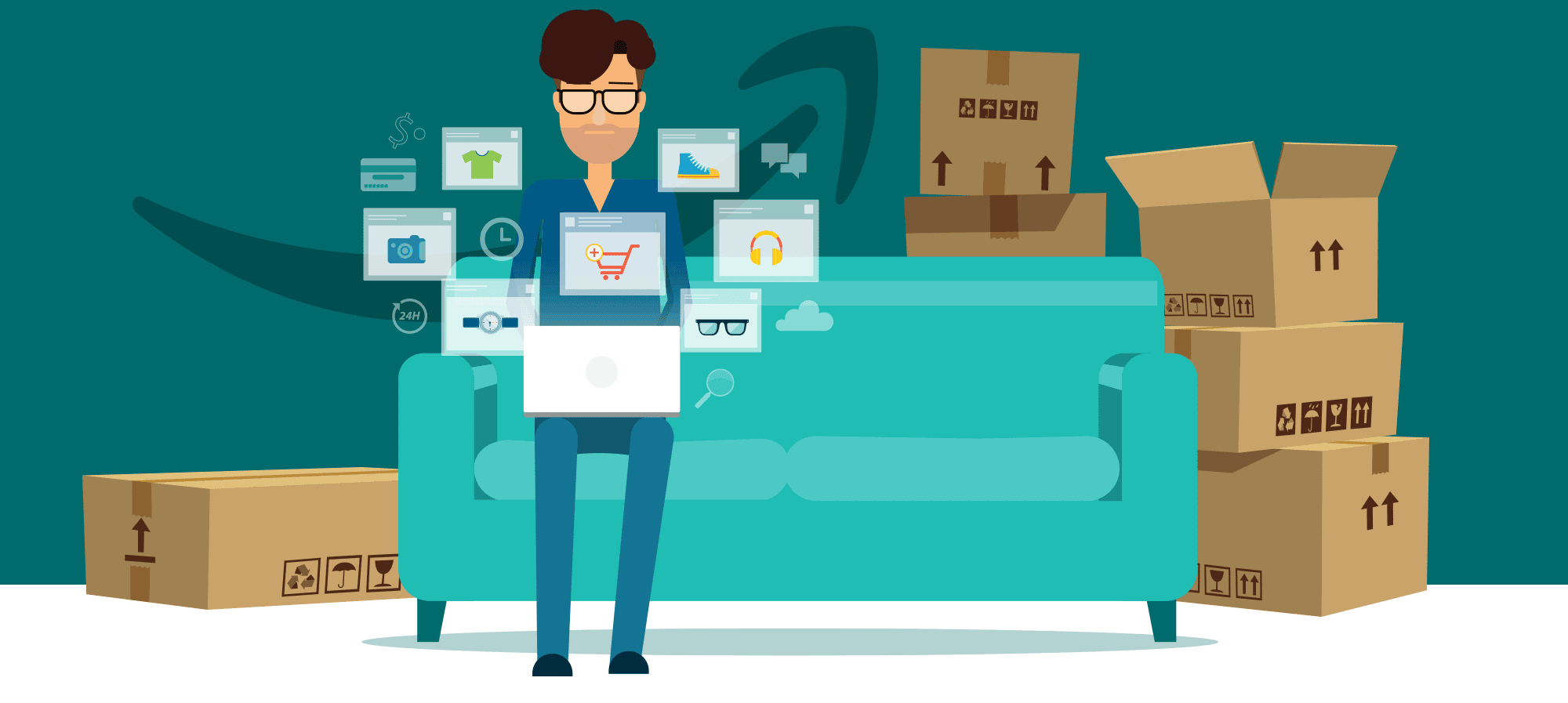
Finding great products to sell is the key factor in running a successful Amazon FBA business. It'll make or break your business. It'll determine whether you're profitable from day one or have to liquidate your products at a loss.
Having launched multiple multi-million dollar brand over the last several years, I'll share with you what has and hasn't worked for me and what can work for you.
Related Tool: EcomCrew's (Free) Trending Amazon Product Database
The Easiest Formula to Finding a Successful Product to Sell on Amazon
99% of people reading this article want the easiest and cheapest path to finding a successful product on Amazon. Here's the easiest path to a successful product on Amazon:
- Find a product where the top selling product sells between $5,000 and $25,000 a month (using a tool like Jungle Scout to determine the sales). If it sells any more, the product is too competitive.
- Find a boring category – no baby products, no pet products, no electronics, no supplements (these categories are too competitive).
- Bundle the product with another accessory. For example, if you're importing fishing rods then include fishing line with it for free.
- Find a good supplier on Alibaba (again, use Jungle Scout's Supplier database to find out exact what supplier your competitors are using).
- Import the product using Amazon Global Logistics directly into Amazon warehouses to get the cheapest landed cost.
There you go – that's the easiest way to finding a successful product on Amazon. It won't make you millions unless you rinse and repeat many times for many products but it has the highest probability of making you some money (I'm not saying it's probable you will make money – Amazon sellers have a high rate of failure).
If you want to find out more details on how to find these products, keep reading below.
Try EcomCrew's (Free) Trending Products Database
EcomCrew hosts a free trending Amazon products database at products.ecomcrew.com. This database reveals trending products on Amazon before they take off. It's a great source of products to launch before they really take off.
Step 1: Generate Product Ideas Using These Tools
Your first step in starting to sell on Amazon is finding a product to sell on Amazon. How do you generate some ideas for products to sell on Amazon? Here's the tools I use:
- EcomCrew's Free Trending Products Database. We developed this tool specifically to help sellers find great product ideas. Our trending products database identifies products that are seeing big growth over the last 12 months. It's by far the best tool for identifying trending products before they take off (and it's free).
- Amazon Product Opportunity Explorer. Amazon's Product Opportunity Explorer is fantastic for generating product ideas and it's free. The problem is that a) you need to have a paid Amazon Seller Central account and b) it's most useful for identifying products already selling well and that are competitive, not necessarily for finding new product ideas.
- Jungle Scout. Jungle Scout is best for determining the estimated sales volume of a product after you have an idea. However, you can enter a broad search term (i.e. Sporting goods) and still get some decent ideas.
- Helium 10. More or less the same as Jungle Scout (see above).
We'll get more into what good products look like below, but try to pick a product that you can build a catalog of five to ten products around. Most successful Amazon sellers have catalogs of many products.
Step 2: Find Out How Much Money Products Make on Amazon
Most of your product research is going to be done on Amazon looking for products that don't have a lot of competition that you can make some small improvements to and profit from.
But how do you find out how much money a product is making on Amazon? More or less, you're going to need some type of software. Jungle Scout and Helium 10 are the most popular (by far). I'm going to include affiliate links for these products but affiliate link or not, Helium 10 and Jungle Scout are the Pepsi and Coke of Amazon software.
Both of these pieces of software are basically Chrome Extensions. With Jungle Scout's Chrome extension I can see that this Scan Disk SD card is selling about $53,000 a month. You can do this with any product on Amazon to find out how much that product is selling.
As mentioned before, you want to find a product that is selling between $5000 and $25,000 a month. Anything more is too competitive. The biggest mistake new Amazon sellers make is trying to target too big of a product to begin. There's lot of opportunity in small product categories but very little in larger product categories.
If you don't want to buy any software, you can get an idea of how competitive a product is by checking out the Best Selling Rank on the product. Typically anything with a Best Seller Rank of 5,000 or below is too competitive (the smaller the number, the more competitive).

Step 3: Find a Product You Can Change and Make A Tiny Bit Better
In today's crowded ecommerce world, you need to stand out from your competition in order to succeed. You need to change those products A BIT and make them different. You cannot just find a product to import on Alibaba, slap your logo on it, and expect to retire in a couple of years.
You'll notice I said make a product different and not necessarily better.
I'm not saying to make a product worse, but making oven mitten in neon green with polkadots instead of the usual grey is different. Better? Not necessarily. But it's different.
Changing product doesn't have to be hard. Here are some ways to easily change your products:
- Make it in different colors/design
- Make it in different sizes
- Bundle it with accessories (i.e. pumps, stands, etc.)
- Sell it in a multi-pack item
- Make it out of a different material (i.e. a thicker rubber)
- Dramatically improve the packaging
Bundling is my favorite way to differentiate my products because it's easy and still works incredibly effectively. Bundling is just taking one main product and including a free accessory or two with it. Take a look at the top listings on Amazon for garlic presses.
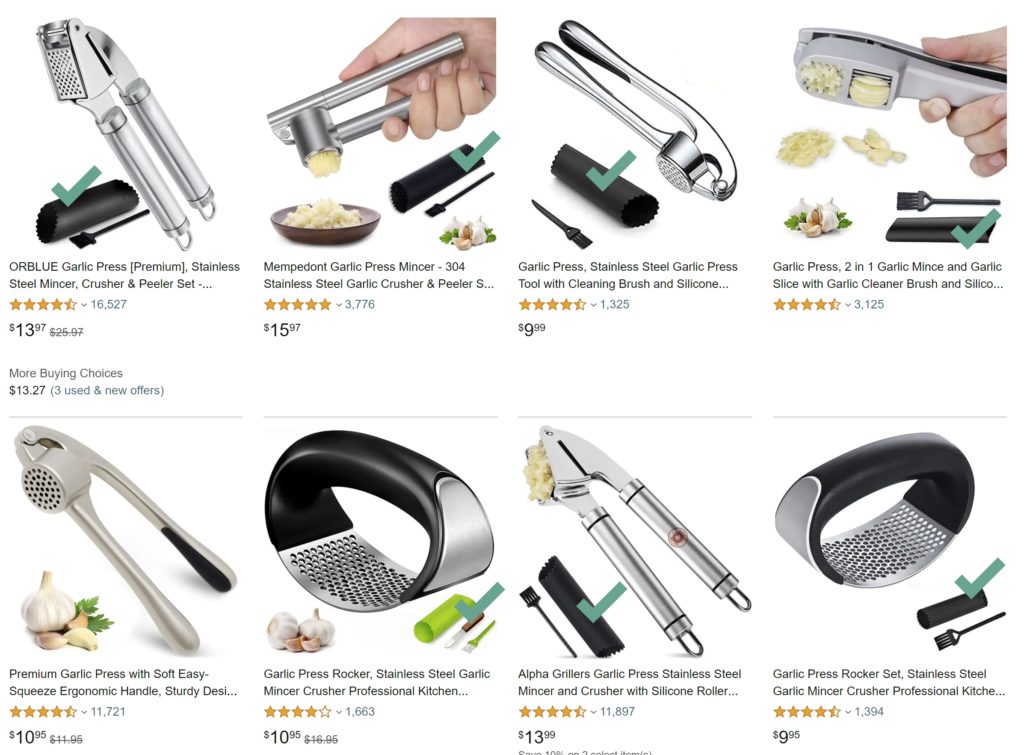
Here's another example with Yoga balls where sellers are easily differentiating their products in a variety of different ways (bundling, packaging improvements and different colors/sizes)
You can also drastically improve your products (think “building better mousetraps”) but it's a lot harder and beyond the scope of this article.
The Cockroach Method for Product Development
I mentioned that bundling has been done to death in the most competitive product categories, especially on Amazon. So what you need to do if you want to succeed is to be a cockroach and go where no one else wants to go. Two areas where many sellers avoid are oversized items and lower demand items.
Everyone wants to have a protein powder or baby product selling $250,000 of products a year and so there is a TON of competition in these spaces. You'll increase your chances of succeeding if you focus on smaller demand items, items selling $5000 to $20,000 a month.
Also, everyone wants to sell a small and easy to ship product like a garlic press that you can just slap a UPS label on and have shipped directly via air from China to Amazon. No one wants to sell boat anchors. They're big, heavy, and you need to arrange pesky sea shipping. But I also sold a business for nearly $1million selling boat anchors because very few others were doing it.
Check out my full blog post on the Cockroach Method if it sounds interesting to you.
Step 4: Find a Supplier on Alibaba
Once you find a great product idea, it's time to start looking for someone to buy that product from in China. The VAST majority of products on Amazon are being imported from China and the vast majority are being found on Alibaba. If you're not familiar with Alibaba, Alibaba is basically a directory of Chinese factories and suppliers.
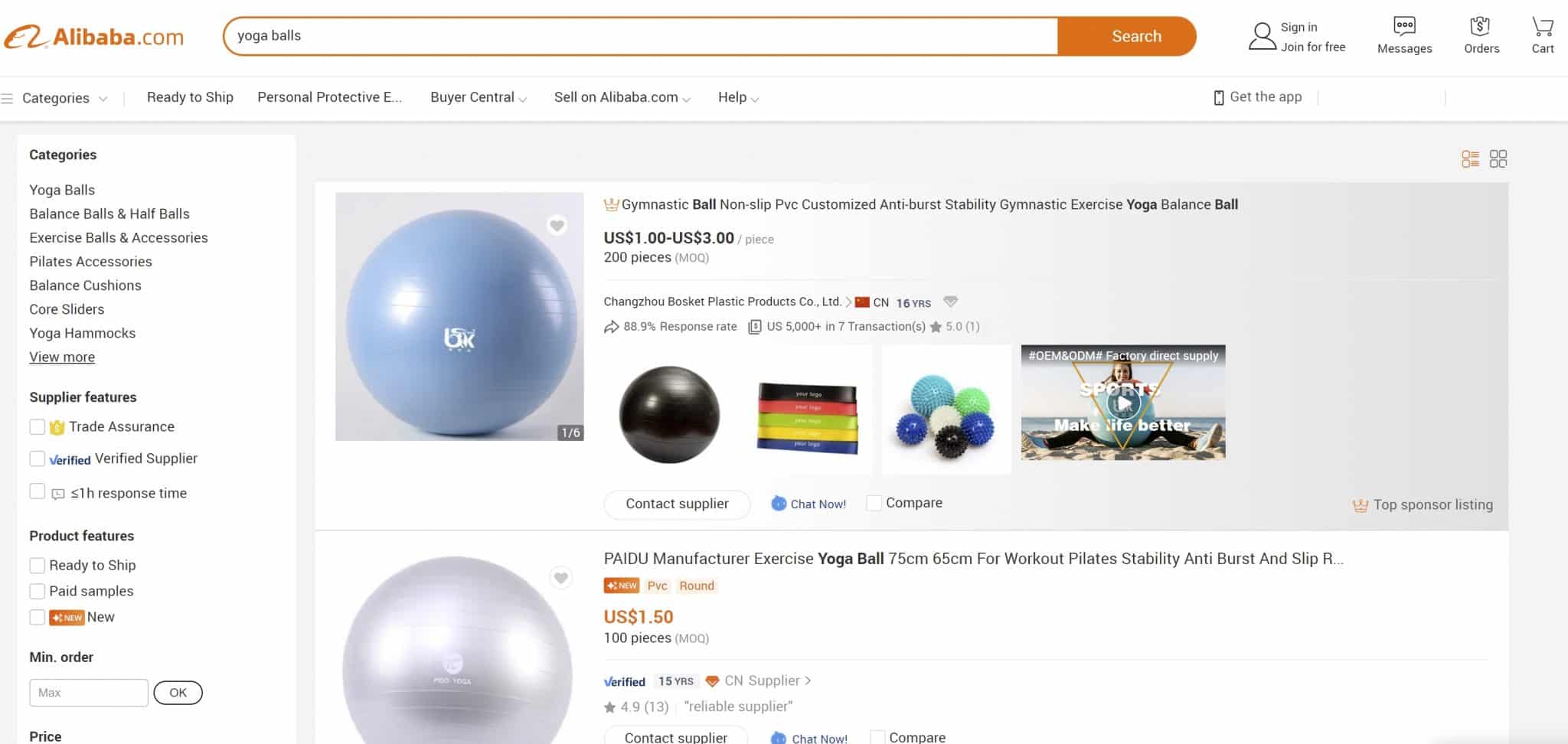
I won't give a full overview of how to use Alibaba as we have a great free guide on how to use Alibaba, but basically you want to do the following on Alibaba:
- Search for your product on Alibaba
- Contact 3 to 5 suppliers to get quotes
- Get samples from the most attractive supplier
- Place an order for your products
Expect to need to spend somewhere between $2500 and $5000 on your first order from Alibaba (yes, it's a pretty big cash commitment).
Step 5: Import Your Products Using Amazon Global Logistics
Once you've placed your order with a supplier you found on Alibaba, it's time to get your products shipped to Amazon warehouses.
You basically are going to have a couple of ways you can do this:
- You can ship all of your products directly into Amazon.
- You can ship your products to your home or 3rd party warehouse and “drip” them into Amazon in small batches.
Ideally, you want to ship all of your products into Amazon at once because it's going to be the most cost effective. There's some reasons why you might not be able to do this (such as Amazon inventory limits on how much you can into Amazon at once) but assuming you can the best way to ship your products is going to be with Amazon Global Logistics (or AGL). Again, I won't go into the nuances of shipping with Amazon Global Logistics as we have a great free guide on AGL.
Ways to Make More Money on Amazon
Alright, now you have a roadmap for finding a single profitable product to sell on Amazon. If you do this correctly, you'll make some money but probably not enough money to retire (and probably not even enough to quit your day job, if you have one). So how do you make more money? Here's a few ways.
Aim to Build a Catalog of 5 to 10 Products
Here's a secret to most successful Amazon sellers – they don't get “rich” by selling one product. They sell several different products and often dozens of different products or more. Every 7 figure brand I've run has had a catalog of 10+ products. Repeat after me: to make a full time income from Amazon you will need to have multiple products.
If you know that you need to have a catalog of several products then the easiest way to make your job easier to focus on one niche. Don't aim to develop products across a bunch of different niches. It makes your job WAY harder.

How do you find a great niche? Well ideally, you have a couple of ideas for a great niche to start selling into. Natural starting points are hobbies that you're already interested in.
However, if you're like most people starting to sell online, you probably have no idea where to start.
Here are a couple of good ways to find niches:
- Amazon 5th Level Category Worksheet [Excel]: Download this Excel document of all the different categories on Amazon. Look for categories on the 5th or 6th level (these are neither too wide or narrow)
- Consumer Hobby Magazines [Google Doc]: Our good friend Andrew Youderian compiled a list of all major consumer hobby magazines in North America. These are GREAT ideas for niches.
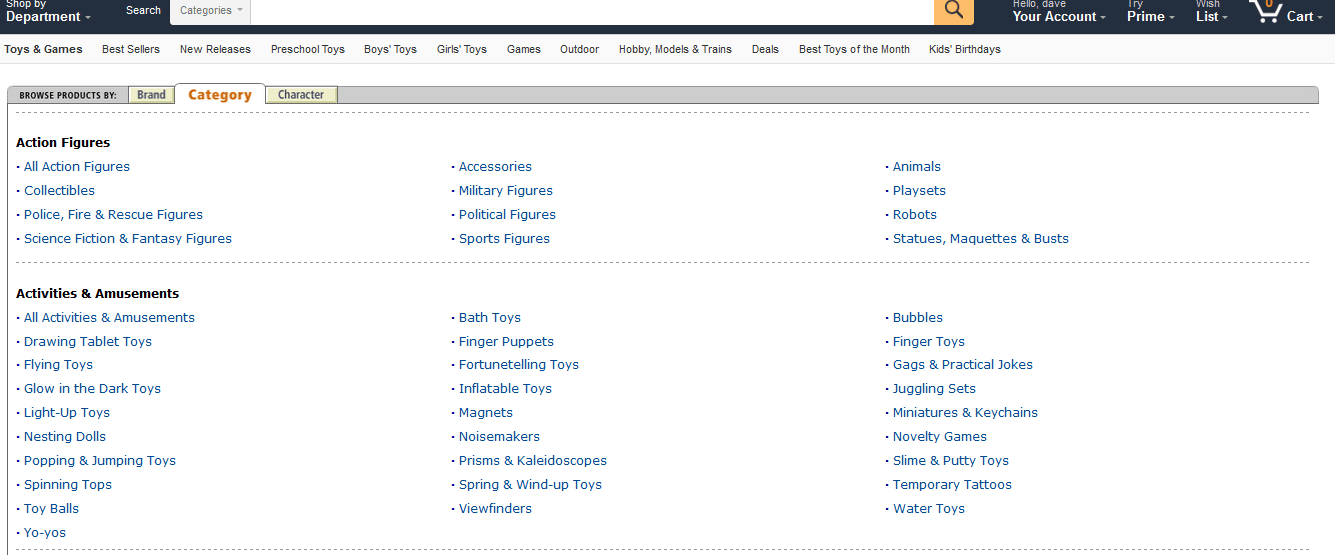
You want to find a niche with a lot of different potential products in it. So, for example, long-distance running would be an example of a poor niche as the number of potential products is very limited. Hiking, on the other hand, would have a near-endless supply of potential products (sleeping bags, tents, hiking poles, etc).
Here are some real-world examples of niches that are too wide, too narrow, and just right:
| Too Wide | Too Narrow | Just Right |
| Wedding Products | Pink Wedding Handkerchiefs | Special Event Linens |
| Fishing Products | Salmon Flashers | Trolling Motors |
| Medical Products | Hot Water Bottles | Hot and Cold Packs |
| Boating Products | Bruce Anchors | Anchoring and Docking Products |
What are the Top Selling Products on Amazon?
Curious what the top selling products on Amazon are? Of course you are.
Here were the most popular searches on Amazon in the fourth quarter of 2023 as taken directly from Amazon's own Brand Analytics search tool. You'll notice many of these products reflect seasonal trends, fads, and, of course, COVID.
-
- Airpods
- Christmas movies
- Stanley 40 oz tumbler
- Christmas Tree
- iPad
- PS5
- Toilet Paper
- Gaming Chair
- Lego
- Crocs
Other Good and Bad Qualities of Products to Sell on Amazon
Here are some other qualities to look for when searching for products to import and sell on Amazon:
- Larger & Heavier Products: Small/light products that can be easily air-shipped have much more competition largely due to the complexity of shipping items via sea.
- Products That Sell for $25+: Higher priced items generally have higher margins which also allows for more money to be spent on paid advertising.
- Products That Are Low Risk: When you import products from China, you are responsible for any damage/harm it causes. Avoid inherently dangerous products (i.e. baby products, hoverboards, etc).
- Products That Are Labor-Intensive: The biggest cost advantages in China come when a product requires a lot of manual labor and little machine labor. Anything that requires a lot of cutting, sewing, screwing, packaging, etc. are going to be comparatively cheap to source from China. Other items that require a lot of machine labor, electronics being the obvious example, normally do not have a significant cost advantage to being made in China.
- Products That Aren't IP-Protected: IP, intellectual property, generally refers to products with trademarks and/or patents. If your product violates someone's IP the product may be suspended from Amazon and/or you may be sued.
How to Keep Your Products Profitable
One of my favorite quotes is that revenues are vanity and profits are sanity.
Comparing revenue numbers in the world of ecommerce is an endemic problem. How many times do you hear someone proudly say they are a 7 figure seller? (I'm guilty of it myself!) The problem is that you can make lots of revenue and have no profit.
Generally, good net margins in an ecommerce business are 20-30% and can often hover closer to 10%, especially for larger businesses with more overhead. Check out our podcast where we broke down the exact numbers in our brands.
There are two ways to maximize your profit: maximize selling price and minimize costs. Differentiating your products is the best way to maximize the selling price. There are several components of minimizing costs but one of the best ways is to minimize your landed product cost. For lowering your landed costs, check out our Importing from China Mega Guide.
Conclusion
This article should give you a good starting point for finding a niche to build your ecommerce company around and then finding products to develop. This entire process can take an enormous amount of time. For my newest brand, I spent months just determining a niche and identifying product opportunities before beginning developing and marketing them. Ultimately, finding quality niches and products lay the foundation for a successful ecommerce business.
Do you have any questions regarding finding a niche or product? If so, feel free to ask any questions in the comments below.
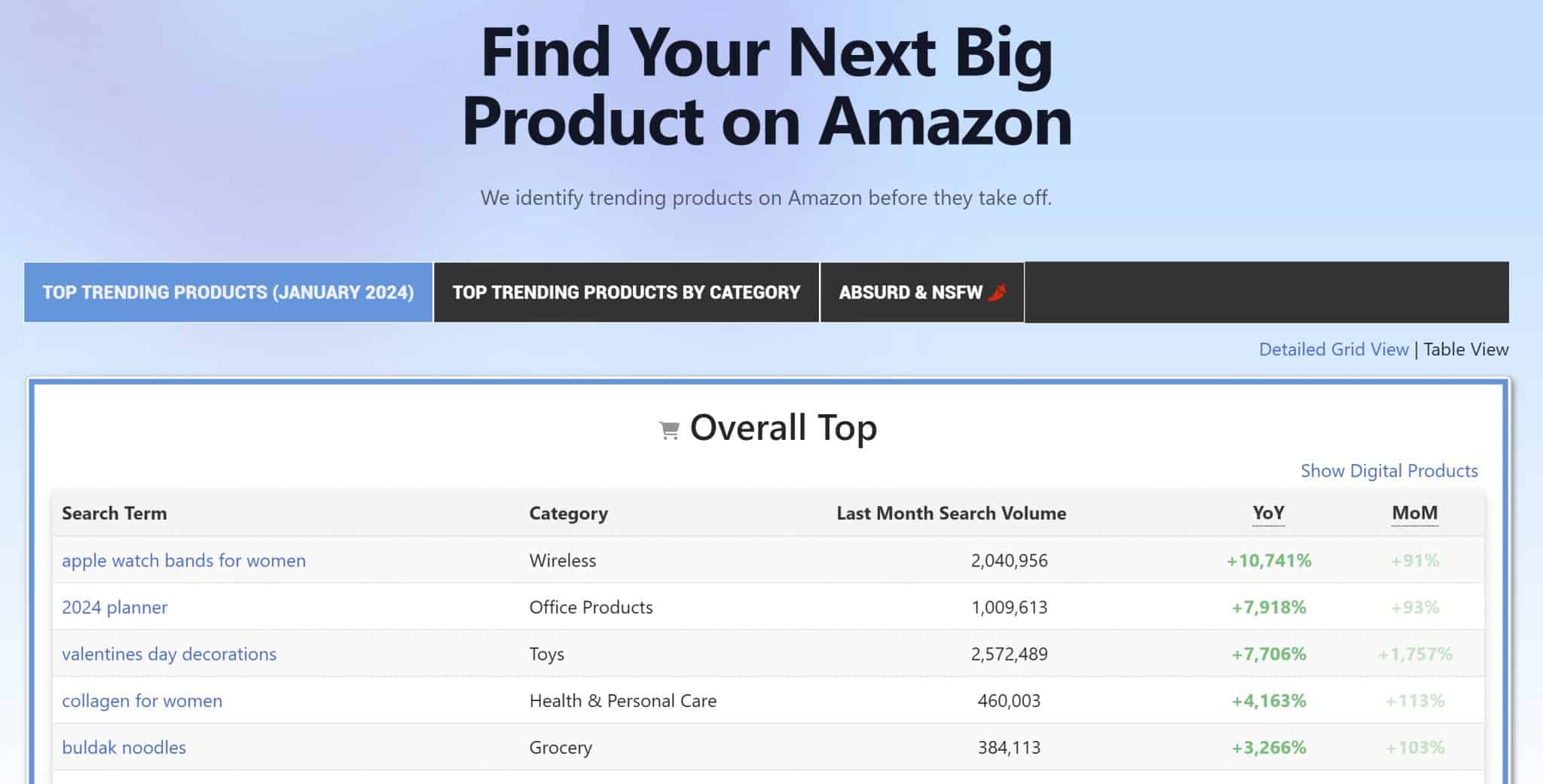
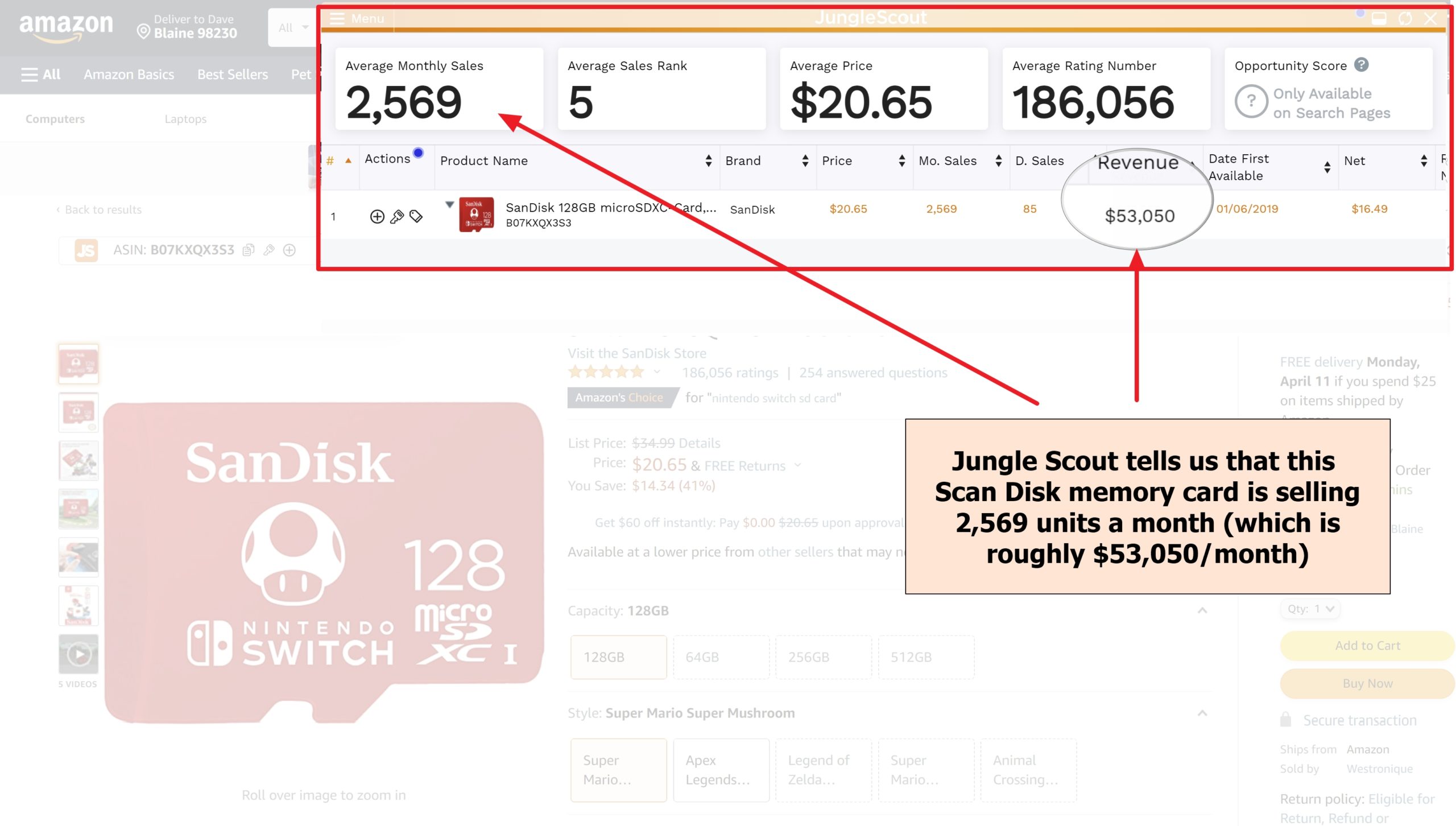
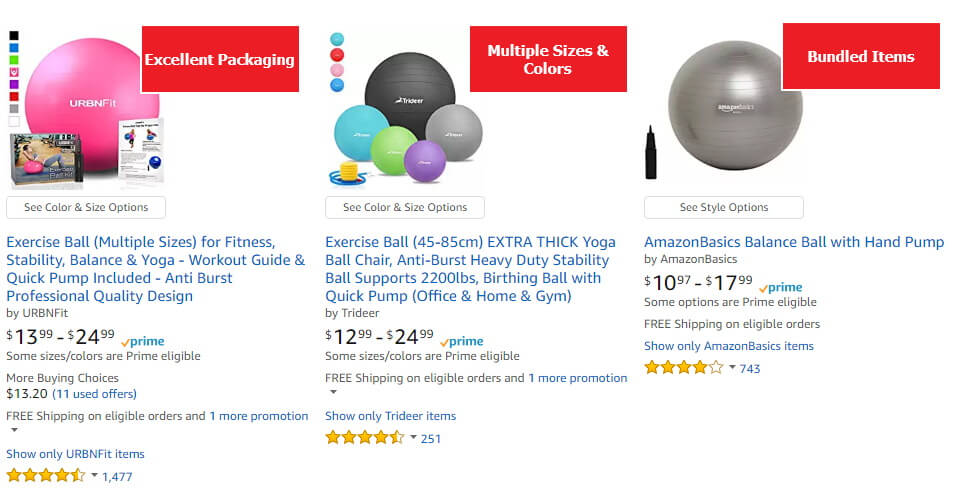
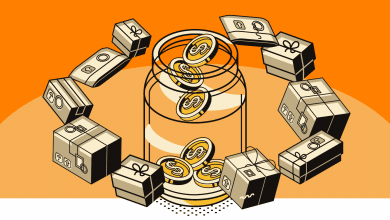

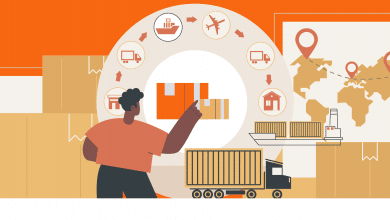
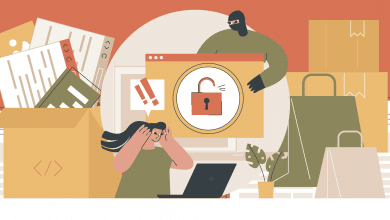
Are there replays available for the webinars?
Hey, Kyle! You can email us at @EcomCrew.com">support@EcomCrew.com and ask for the webinar you interested in. We’ll be happy to share the link with you!
hola , me gustaria tener acesorias de ustedes.
como puedo comunicarme ?
Hola, Joselito! Nosotros no ofrecemos servicios de consulta. Sin embargo, nosotros tenemos un servicio llamado EcomCrew Premium que puede interesarle. En esta suscripción tenemos un poco de todo para vendedores en todas las etapas, pero una gran parte del contenido de EcomCrew Premium está dedicado a ayudar a las personas a construir negocios desde cero. Si le interesa, usted puede obtener mas información en este enlace: https://my.ecomcrew.com/ecomcrew-premium-lp-1
Hi Dave,
You mentioned you use low search volume keywords to start off your search for potential products. What other criteria are you using beside just search volume?
If we are looking for products that can potentially bring us a revenue of $5000 to$10,000, many a times, products with such low search volume is also an indication of the low demand and hence unlikely to give us the desired revenue.
Also, in using such a low search volume keywords as the main keyword, how do you decide the use of more relevant keywords? The search volume of other relevant keywords would likely be even lower. In totality, what amount of search volume would you consider, when adding up all keywords search volume, to be sufficient in deciding on a product?
Ann
Ultimately I’m looking at products that can bring in somewhere around $10,000/month. There’s two parts of the equation: search volume and then conversion rate. Search volume is easy to estimate; conversion rate not so much as there’s a lot of factors that can impact it, i.e. i.e.how differentiated am I making the product (if it’s more it’ll lean towards higher conversion rates), the number of competitors, etc.
Great info, Thanks, Dave.
Question on Differentiation: if we make changes to the product like design, functionality, bundle, material, size.. etc.. How to validate the changes we made to the product..?
How to make sure changes are actually required to customers and have demand for those changes.
Thanks.
Best way is to launch small and see if it sells :)
Hi Dave,
i’ve a couple of questions.
You mentioned about starting off small when first getting started.
1) What’s the qty of the product would you consider to be a good start to buy to do a test-run?
2) If we were to start with a small qty, would it be better to buy from sites like aliexpress or 1688 rather than going direct to alibaba as most suppliers from alibaba would likely quote for 100’s if not 1000’s.
3) Do you source all on you own or do you use a sourcing agent?
Lastly, do have an article or podcast where you cover the launching of a new product using only PPC ? for the first test run, I suppose because of the small qty that we will be buying, not likely to be able to do give-away and as such PPC would the only option.
Ann
1) 25-100 units.
2) Aliexpress maybe. 1688 is even less likely to give you low MOQs than Alibaba.com
3) On my own.
Check out https://www.ecomcrew.com/amazon-product-launch-strategy-focusing-on-off-amazon-traffic/
Do you mind if I quote a few of your posts as long as I provide credit and sources back to your webpage?
My blog site is in the exact same area of interest as yours and my users would
definitely benefit from some of the information you provide here.
Please let me know if this okay with you. Appreciate
it!
As long as it is under 100 words that you’re quoting :)
superlove this, really like your content Mike and Dave. This blog post strategy can be used instantly in any e-commerce business and I found. Thanks!
Hi Dave and Mike
Great work on the blog and podcast!! I am really enjoying listening to you guys. Just starting out so not ready yet for premium but learning a TON from all the free stuff you guys put out. I have a quick question about your statement “A good rule of thumb is to assume you have to mark up your costs by 300%” (or buy for x, sell for 3, 4, or 5x – I have heard Mike talk about moving into the sell for 4 or 5x range). My question is when you say this – are you referring to manufacturer’s (FOB) cost or your landed costs? So does the 300% markup cover the shipping, as well as advertising and other expenses (and profit of course) or are you talking about 300% mark up of the landed cost?
Thanks
Hi Moshe – normally we’re assuming a 300-400% markup on the FOB cost (so not taking into account shipping and other costs). That’s why the 3-4x cost markup is needed :)
Hey Dave,
You guys have great content! I’m just getting into Amazon FBA. Living on Vancouver Island and selling in the US. I’m very tempted to join the Ecomcrew Premium class.
Hi Hans – we’d love to see you there.There’s several Canadians with us. We try and make Premium very hands on, so I don’t think you’d be disappointed :)
Hi Dave.
I want to import to the US from China. However I’m neither a Chinese nor an American.
Is it possiblegal for me to do so?
Kindly am asking if i can import African ornaments from Kenya and sell via amazon?
You’d need to check with a customs broker but I can’t imagine any problems assuming they don’t have any restricted materials in them.
Great article. Thanks for the categories spreadsheet. Can you explain, how we can go about refreshing that spreadsheet as Amazon does make changes to the tree from time to time. Many thanks.
The spreadsheet is for niche idea generation – the actual structure might change but the number/types of categories should be relatively stable.
Hi and thank you for the quality of the information you give.
As Gary said above, I would like to create a online business but not selling in the US and maybe not by Amazon. In addition I do not want to import from China, so I don’t think your site is good for me. What’s your point of view on that ?
Is there still a value that I joint ecomcrew premium ? If not could you suggest me another good site that could help me doing what I want ? Any suggestion ?
Thank you very much in advance.
Hi Ben – about half of our audience is non-american so that part isn’t an issue. However, if you’re not building a private label brand importing from China or selling on Amazon then that probably leaves dropshipping. Nothing wrong with this, but, for better or worse, that’s not the focus of Premium
Very helpful , especially the spreadsheet of the 5th level categories. Thanks
Thank you.
Hey Dave let me get this straight all I do is go online amazon ect…..and find products that I can make improvements on or sell cheaper online on your own website??? Not sure how it works but to find out thanks really I interesting please lmk how
Yes, “all” you do is build awesome products like the instant pot and checks roll in :)
I had no idea about the deal between China and USPS, that’s unbelievable!!! I would think that the US Government would want US sellers to profit and have successful businesses since the money will be spent here…… My question is, do we as US based sellers have any type of deal like this with another country? So we could target shipping to that country. :)
Hehe, unfortunately it’s setup where developing countries get a discount and higher income countries pay more.
Thank you for sharing such a great guide!
You’re absolutely right, 98% of the sellers first find the product and don’t even think about the niche, they just jump right to making it. I always like to think of the brand first and what it has to offer rather then BINGO! I found my product.
Another issue that I’ve seen over and over again is supposedly finding a product, taking 2-3 month to develop and send it to Amazon and by then the niche is flooded by Chinese sellers with a very similar product and a ridiculously low price.
Personally, I’m all for real differences that can be found in:
– ordering competing products and looking at what they lack
– Amazon Q&A
– the competitor reviews
& even keyword research
They should all be able to give you very good ideas on exactly what you can improve.
Don’t get me wrong, bundles are great BUT they’re very difficult to capture in a photoshoot or emphasize in a listing. Besides, the accessories are usually of lower quality which, to me, is no differentiator.
I’m a BIG fan of oversize products simply because most courses advise sellers to invest in like 1000 pcs of small & list inventory whereas those products are just too competitive and finding and advantage is very difficult for someone who’s just starting out.
Quick tip: open a company outside of the US to steer clear of any legal issues. It’s quick, it’s cheap and it could really save your business.
There’s a pretty good course on Lynda about how to search for and read a patent. That has come in handy quite a few times over the years. Amazon does not take these things lightly and the patent holder either wants Amazon monopoly or will make you pay royalties.
Thanks again for all the great info!
Awesome tips Kassandra! Never even really thought about the benefits of opening an overseas company that’s far away from the grasps of the American legal system.
I believe this is the course for anyone us reading this: https://www.lynda.com/Business-Communication-tutorials/How-search-existing-patents/365278/441558-4.html
Thanks for the detailed guide. Love listening to your podcast as well as reading the blog.
Thank you guys! Very useful information
Several things in here that I had no idea of. Thanks
Great knowledge. Thank you!
Thanks for the detailed guide. Will try to implement the suggested techniques and see how it goes.
Great info, as always! Best podcast out there also.
Keep it up!
Thank you!
Hey mister man – thanks for the lovely knowledge – just a quick typo for you: (shipping items via air from China has a lot lower investment cost than shipping via air) … should end with *sea, I assume. =)
Thank you!
Hi, Thankyou for the information. I want to ask If Im not selling to US and not selling on amazon. (I sell products on my country). Still i get values from joining ecomcrew premium ? Thankyou
Hi Gary,
We cover a lot about product development and sourcing so I suspect you would still find plenty of value.
Hi Dave
I found a niche here in Australia can I email you
We limit our private 1 on 1 support to premium members but you can ask anything here :)
Hi David,
hope you will be fine.
i want to start a new small import business could you please advise me the list of products which will helpful to make profit in Pakistan.
nope- it varies from person to person. I can only give you general tips, not specific products :)
Hey guys,
Wondering if you could answer this question for me. Sorry there’s a lot of background to read first..
This is my first order, and
I have a few different pieces to my final product (bag, boxes, inserts) coming from different suppliers.
I planned to have all the boxes put together and shipped together ocean to save me on air shipping the smaller supplier’s orders separately, some of which are only 2 or 3 boxes.
Well, the timing got really squeezed, and now I realize I may have screwed up the logistics despite my best efforts (and hiring a freight forwarding company).
My shipping agent is telling me that I need to ask these suppliers for FOB terms. The suppliers are coming back and saying they don’t want to do FOB, it’s too expensive, as it seems there are base fees no matter how large the order that they must pay. I’m not sure if my agent realized that some of these orders are really really small, as in the 1-2 boxes range and less than 0.5 gross CBM, but he isn’t exactly inspiring me with confidence with the way they’re handling this or answering my questions.
So my questions are two part.
1. How do I handle this order? It’s possible to get all the boxes to an ocean port together, but each supplier has to pay FOB? Meaning I’m gonna get hit with a big bill.
2. How do I handle this in the future? Ideally , I’ll have the suppliers ship everything to the main factory, where they will put the finishing touches on the boxing so that everything is together and there are no more assembling steps… Do I just have EXW terms with those smaller suppliers and have the bigger supplier put this on onto their invoice, pretending that the extra supplies came from them? Also, done this way, I think i can’t use alibaba, because Baba orders need separate shipping confirmation details entered…
thanks for your help, as always.
1. You need to either ask your Supplier for FOB terms (and tell them you’ll pay extra) or tell your agent youll pay the extra fees for EXW. The biggest cost for your Suppliers with FOB is getting the goods from their warehouse to the port. Depending on the size of the order it will probably be $200-300 extra each.
2. Yes have everyone send it to the main suppliers. As for Alibaba, I never use their trade assurance program (or whatever they call it) but if it’s a problem just don’t use it :) Most people for larger orders just use alibaba as a directory, not as an actual ordering platform.
1. Your supplier likely will have no problem shipping fob but you’ll have to pay for it. The freight cost from your suppliers factory to the port will be the most expensive component- some suppliers can be hundreds of miles from the port. Expect to pay $200-300~ for each shipment. If your supplier insists on EXW let your forwarder know the terms are EXW and to charge you accordingly.
2. Yes have them all ship to the main supplier and consolidated there. I’m not familiar with alibaba’s trade assurance program (I never use it) but on larger orders you can’t use it anyways so if it’s a problem, just don’t use it :) Just pay your suppliers directly.
Please follow up with how you make out. It’s valuable insight for other readers :)
Dave thanks for the reply. here’s my update as promised.
My confusion mainly stemmed from my desire to combine several orders and my FF being unaware of this.
I think both of us share responsibility for the misunderstanding, them for not paying the attention they should have and me being the inexperienced first-time buyer.
My FF and suppliers then were telling me that separate FOB costs for these small orders was cost prohibitive, and I might as well ship it by air. They did not know I wanted to combine orders, as that is not something they are supposed to get involved in.
Because I didn’t plan well enough combining is not possible this order and i will need to pay extra $1500 or more.
My lesson from this is that now I know how the process works, next order I will plan so that my orders are consolidated into my main supplier’s warehouse where they will assemble the different suppliers’ orders together for me. The smaller suppliers’ terms will be EXW and this will be outside Alibaba now that I have a relationship with them. I guess they will function as a local supplier that provides goods domestically to my main supplier, who will then list everything together on one packing invoice and packing list.
This gets into a gray area that my FF couldn’t admit to having knowledge of; they are supposed to just ship what’s on the PL/PI and that’s where their involvement ends.
Going forward I think this is just one of those lessons you need to learn as you go through it. Next order I will be more prepared for sure.
Thanks again for this awesome resource.
First orders always have a bunch of ‘gotchyas’. It happens to everyone – I just paid $1000 in a poor estimate of ground shipping costs in China around Chinese New Year. By the second and third order though you should have all those wrinkles ironed out and you’ll hopefully make a bunch more money :)
Hey Dave (or Mike),
Mike mentioned on an earlier podcast that he uses his Credit card to pay suppliers, racking up rewards points.
I’m guessing you guys aren’t using Alibaba (2.8% cc fee) on these orders so how exactly do these factories in China accept credit card? Paypal fees are a killer so I’m guessing you’re not using paypal.
Thanks
I think Mike is paying mostly domestic suppliers and vendors, not overseas suppliers.
Do you know of any American manufacturers rather than manufacturers in China? Products just take so long to come in from China would love to get products from American manufactures.
There’s tons (just ask Trump!). Check out this post here: https://www.ecomcrew.com/how-to-make-a-product-china-vs-the-usa-and-western-countries/
step 3: dont choose a niche that competes with amaon
step 4: use amazon category tree to find niche.
……………………. lol
There’s no contradiction – the Amazon category tree lists every category – it doesn’t mean they’re aggressive sellers in that category, especially with Amazon basics.
Hi dave, I’m planing to import from china to Australia. I want to go there myself and inspect the quality. My question is which city should I go ? Which city of china is the best for importing high quality products such as shoes, mobile accessories,
You should start by visiting a fair like the Canton Fair – see our guide for it on this site :)
Hi David,
I’m going to be joining your Chinese Importing Course. Do you offer feedback as we go through the modules? I would like to run a product idea/niche by you for any obvious pitfalls. Thanks,
Jason
Hi Jason – yes just send me an email (instructions from within the course to make sure I see it :))
Thanks, David. Will do. :)
Dave-great info!
I’m in the stage of targeting an item. Regarding marketing, Amazon & EBay, amongst others, are certainly viable avenues but would you not rule out, in addition, having your own website as well?
Hi Rob,
Yes- for sure you should have your own website as well. See the latest blog post on eBay for a summary of the channels I suggest and the order I suggest in launching them.
Hi David
I want to import a product from China, maybe in hardware or kids toys, What do you think is the best product I could import from China to USA that has less risk and have consistent base of buyers please?
Thank you
Hi Zack,
If I knew those products I would be importing them myself :)
Hi Dave,
Great blog, I wish I had read your article before I made some serious blunders.
I am looking for some building products, for construction company’s meeting green house agenda, what do you recommend.
Kind regards,
Edward Francis
Are you asking for what building products I recommend to import to make a bunch of money from?
Yes, Dave.
Hi Dave, your blog is great. I want to refer to your articles/comments about finding a niche, and the one about starting with a product that retails for over $50. Referring to the articles about Model Railroading supplies and serving spoons … great ideas! And I feel my ideas fit your comments regarding those niches; however, the expected retail for my first few items will only be $15-30. Am I destined to fail? … or do I have a chance if they are niche products? (and certainly won’t be available at the Big Box stores)
Hi John,
There’s plenty of people who do extremely well in that price range. For me personally it’s not my target – especially with paid advertising costs per click often exceeding $0.5 for ANY product it doesn’t leave a lot of room for error, but that’s just my safety zone :)
Hi dave!
Great website.. i was looking for your email address out here but could not find it… wanted to get your opinion on my new start up importing a certain product to india..
Looking forward to hearing from you!
Hi Dave,
I ordered something my children really wanted from China. There was only one U.S. Seller and they wanted thousands of dollars for the product. I was able to get it from China for 1/3 the cost. It took me a longtime to source a reputable manufacturer. Now I am inundated by people who also want one. I would like to start a business importing this new on the market product but where do I begin? I found the factory in China and my import customs agent to be outstanding and very legitimate. Now what do I do?
Thanks,
Melissa
Hi Melissa,
Way too broad of a question but the Chinese Importing course is a good place to begin :)
Hi, I have limited experience in any aspect involving business but I have been thinking is importing a product a viable business. I have been thinking what product would be a good product. I have been thinking about storage cardboard boxes and other storage materials as I have come into problems with storage in my personal life and have trouble finding anything conviently. Do you think this type of product could be profitable?
Hi David,I want to know about the adult diapers importing business may I know how is that businesses please send me the details to my gmail
Yes, I will email you a white paper on the strengths and weaknesses of importing diapers along with the full details of exactly how to do so shortly.
:-)
Doing bags business in india. Well I’m not going to import any branded bags . I’m a new guy going to Guangzhou on October end for Canton fair . So it might be useful for me ¿¿¿¿ . And I’m buying bags from a importer which they are a sourcing agent they doing lot of stuffs here so they are filling a container with bags machines furniture automobile&etc . So my question is if I can could be direct importer from china which my goods can be cheaper wen I import fr my self Bt a main thing is I hav a small quantity of customer here .
Hi, I’m not sure what the question is? Are you asking if you can import directly instead of using a sourcing agent?
Hi,dave, i wanted to know if its normal lose money on your trial order from alibaba as i am paying a lot of money for shipping. i understand that it is air freight, however will future orders shipping price be different. thank you
Hi,
Personally I never expect to make money on a trial order – but I always import with the expectation that I would be able to make a profit on the order if it was a larger quantity on subsequently lower freight costs.
Hi Dave,
I have a niche in mind, but there are already a lot of on-line stores in the arena. My question is, how do you decide if your idea is viable? For example, why did you c your niche? Was there no, or little, competition when you started?
Hi Mel,
I chose my niche because I had a fair bit of knowledge in it and I was passionate about it. I simply started ordering small and seeing if things stuck. In fact, this is what I do today. With a Supplier I’ll try and order as few of items as possible, list them, and hope to get sales traction. In today’s Alibaba day, there’s competition for nearly any products, but hopefully you’re able to give yourself a competitive advantage on either marketing it better (great pictures are an easy way) or slightly improving the product.
With that being said, it’s much more important to chose a good industry opposed to product IMO.
I was wondering how you decide on what is a great, profitable product ?
Now that is way too broad of a question! :)
I thought that finding good “wholesalers” on the Internet would serve me well, Well, not so fast. I went to local wholesalers, some who don’t have websites, and their prices for goods are insanely cheaper than those on the web. A dozen pair of diabetic socks for FOUR DOLLARS less than web sellers, no shipping too, since they are local.
hi! im looking for gilmour gardening tools and spray cans,
Hi charlene,
This is a trademarked product and you would have to contact Gilmour directly.
Hi David,
Do you have any experience in custom molds?
I’m being quoted 3 to 5k for a simple enough mold if a rubber object that is 12cm X 4cm X 6cm. Does that sound right to you?
I keep reading about customisation and changing spec, but do we really need to pak 3k for custom mold?
Thanks
Ps. Love your blog
D
Hi,
I’m by no means a molds expert, but IMO it doesn’t sound entirely off. Here’s an American plastics company’s overview of mold costs: http://www.rexplastics.com/faq.php. I would try and get a competing quote from another Supplier though. It should be noted, things like mold costs often go hand in hand with MOQs- if you order enough, they may offer to subsidize that mold cost a bit.
My two cents worth regarding Danny’s question about having custom molds made for a new product. I had the same issue a couple years ago on a product that I eventually had patented, but needed some down and dirty cheap plastic parts made.
I scoured the local Craigslist and business directories and found a little old guy who had an injection molding machine in his garage of all places! Albeit primitive, he also had the metal working tools he needed to make the mold set that I needed for just a few hundred dollars using a mold set from a previous project he just made some modifications to.
Scour the local industrial complexes where there are tiny mom and pop sheet metal and machining companies… likely someone will know somebody who can get this done for you! Hope this helps, all.
-Don
Totally agree Don- I think it’s a sign of the world we live in that people think the only place to get something manufactured is China :)
Hi Don,
I’ve heard of similar stories. Some cities even have ‘open shops’ where you can pay an hourly fee to produce your own items. Here’s a great podcast episode to listen to regarding this: http://www.ecommercefuel.com/the-roost/
I find when i’m on Alibaba or DHgate it’s really difficult to tell the ranking of quality for their clothing. A lot of the pictures they use are from successful fashion companies. Are their ways to specifically find good quality clothing? My company is quite small so i’m also ordering small quantities which throws another problem into the mix. What would you suggest for a small business looking for small quantities of high quality women’s clothing?
Hi Mae,
Alibaba and Dhgate won’t tell you about the quality of a Supplier’s products- for better or worse you have to order samples and/or build a relationship with your Supplier. You’ll want to order a sample of the fabric the Supplier is using at the very least. I did an interview with Steve Chou recently who imports handkerchiefs and you might find some useful information in the interview there: http://www.chineseimporting.com/interview-steve-chou-from-mywifequitherjob-com/
Hey David
Great post here on dealing with a chinese product selection.
I have been living in Guangzhou for the past 3 years,and all what you’ve written is amazingly to the point and true,but i think the best way to approach this as well is to modify or merge a current product adding a feature or two,even then a congested marketplace will note a product with a new or extra feature.
Yes- great point. Improving on a product is the logical evolution from importing a completely off the shelf product, but the latter is a great first step for the former :-)